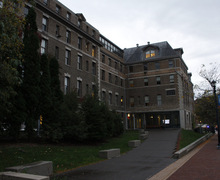‘Ant-Man and the Wasp: Quantumania’ review: Flop to start Phase 5
Emma Lee | Contributing Illustrator
Leading up to the release of ‘Ant-Man and the Wasp: Quantumania,’ there was plenty of excitement from Marvel Cinematic Universe fans. However, the movie they saw was a messy, special effects filled disappointment.
Get the latest Syracuse news delivered right to your inbox.
Subscribe to our newsletter here.
The “Ant-Man” series has always served as a welcome diversion from the grand scope of the Marvel Cinematic Universe. The shrinking hero’s first outing was a self-contained heist story with more relaxed stakes than most other superhero projects, and its 2018 follow-up was a similarly mellow caper.
This down-to-earth energy is missing from the newest installment, “Ant-Man and the Wasp: Quantumania.” Computer-generated excess and dull franchise building replace the simple, earnest fun of the original movies. The result is one of the messiest and least satisfying Marvel adventures yet.
“Quantumania” is stuck with the heavy burden of introducing the MCU’s next overarching villain, Kang the Conqueror. This forces the movie to adopt Marvel’s typical style of galactic-scale action, which is a bad fit for a lighthearted character like Ant-Man. Every Marvel movie inevitably ends in an epic CGI showdown, but only the first two “Ant-Man” films were grounded enough to pay a visit to Baskin-Robbins along the way.
After the events of “Avengers: Endgame,” Scott Lang (Paul Rudd) is resting on his laurels, promoting a memoir about his exploits in the fight against Thanos. Behind his back, Scott’s teenage daughter Cassie (Kathryn Newton) has teamed up with Hank Pym (Michael Douglas) and Hope Van Dyne (Evangeline Lilly). The trio creates a machine that sends signals down to the Quantum Realm, a subatomic dimension where Scott was trapped for five years between “Ant-Man and the Wasp” and “Endgame.”
When Cassie, Hank and Hope eventually show the device to Scott and Janet Van Dyne (Michelle Pfeiffer), Hope’s mother, it malfunctions and transports all five of them into the Quantum Realm. They discover a colorful environment populated by surreal creatures, including anthropomorphic broccoli and a community of sentient skyscrapers.
Kang the Conqueror (Jonathan Majors), a scientist who crash landed in the Quantum Realm while traveling the multiverse, rules over this microscopic world. Kang has used his advanced technology to build a brutal empire across the Realm, but he’s eager to escape. His only way out is to capture Ant-Man and use the hero’s size-altering technology to repair his damaged spaceship.
To accomplish his plan, Kang has allied with Darren Cross (Corey Stoll), the villain from the first “Ant-Man” movie who Scott banished to the Quantum Realm. Darren now lives as the cyborg M.O.D.O.K., a massive floating head who steals every scene he enters. M.O.D.O.K. is one of the film’s rare highlights, an entertaining blend between comic relief and loopy science fiction.
All this talk of Quantum Realms, multiverses and parallel dimensions will likely overwhelm everyone except the most diehard Marvel fans. The lengthy expository dialogue explaining each new concept is downright headache-inducing. But by now, this is the default mode for Marvel movies. The spacefaring pivot that began with “Guardians of the Galaxy” has consumed the MCU entirely.

Bridget Overby | Design Editor
In Marvel’s earlier phases, the Avengers would team up to defend real-world locations like New York or Eastern Europe. Now even the solo films dedicated to minor heroes like Ant-Man and the Wasp are all about playing Mad Libs with sci-fi jargon — incursions, variants, alternate timelines, mechanized organisms and multiversal power cores — until your head spins.
It doesn’t help that the Quantum Realm is brought to life with the sloppiest overuse of special effects in Marvel Studios’s fifteen-year history. Practically every character and location is the product of digital movie magic, a far cry from previous “Ant-Man” movies. By the film’s end, audiences may be fatigued by the sheer volume of visual effects crammed into each frame.
Director Peyton Reed’s greatest strength is his sharp eye for comedy, and he gets to put that talent to use in “Quantumania.” The opening twenty minutes, set in San Francisco, contain the funniest material in any superhero movie since “Thor: Ragnarok.” Once Ant-Man and company are sucked into quantum space, however, Reed’s skill set doesn’t transfer over. The Quantum Realm is a cluttered mess that usually looks more like the iTunes visualizer than an exciting new world.
“Quantumania” is at its most tedious whenever Kang is on-screen. Jonathan Majors is one of the most talented actors to ever appear in the MCU, and he tries to make the Conqueror compelling. Still, Kang is such a self-serious bore that it’s impossible to buy into his character. His dreary, vague soliloquies about time travel are hard to sit through, no matter how much Majors commits to the part.
Kang may have the ability to visit infinite dimensions, but he’s painfully one-dimensional, a tyrant obsessed with conquest at all costs for no particular reason. Even if his backstory is intentionally shrouded in secrecy to set up future projects, the lack of clear stakes hurts this film. At least when Ant-Man is around, audiences can expect a healthy dose of humor to wash down the green screen chaos. When Kang appears, the movie just becomes a slog.
Paul Rudd, Corey Stoll and the rest of the cast do their best to bring some playful charm to the movie and remind viewers of what they loved about “Ant-Man” in the first place. Despite its efforts, “Quantumania” struggles to find a solid justification for itself beyond setting the table for future “Avengers” movies. It feels like a film designed to advertise the arrival of Kang in the MCU rather than a film looking to tell a real “Ant-Man” story.
Published on February 20, 2023 at 9:17 pm






